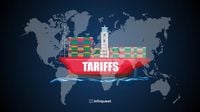In a notable shift in economic indicators, Saudi Arabia's core inflation rate surged to 2.3% year-on-year in March 2025, marking the highest rate since mid-2023. This increase reflects widespread price pressures across nearly all categories of the Consumer Price Index (CPI), suggesting that inflation is set to remain above the 2% threshold in the upcoming quarters. The inflation figure for March slightly missed the forecast of 2.4% by Capital Economics but exceeded the consensus estimate of 2.2% from the London Stock Exchange Group (LSEG).
When adjusted for seasonal variations, prices rose by 3.6% year-on-year. A deeper dive into the data reveals that the rise in inflation was particularly pronounced in food and beverage categories, which saw inflation jump from 1.0% year-on-year in February to 2.0% in March. This increase represents the highest rate in two years and is attributed to significant price hikes in essential items such as bread, grains, seafood, and vegetables.
Moreover, non-food inflation in Saudi Arabia also accelerated, reaching 2.4% year-on-year in March, despite a slowdown in housing and utility costs, which constitute the largest segment of the CPI basket. Analysts from Capital Economics predict that core inflation will stabilize within the 2.0-2.5% range for the next two quarters. However, they also forecast a potential decline in 2026, with inflation possibly dropping to around 1.0% year-on-year, primarily due to lower inflation in non-food categories, especially in transportation and utilities.
Meanwhile, across the Atlantic, former U.S. President Donald Trump made headlines on April 15, 2025, by announcing that prices for nearly all commodities, including gasoline and groceries, are set to decrease if he returns to office. In a post on Truth Social, Trump asserted that inflation in the United States is on the decline, although he did not provide specific data to support his claim.
His comments come on the heels of data released by the U.S. government on April 10, which indicated a surprising drop in the Consumer Price Index (CPI) for March. According to the U.S. Department of Labor, the overall CPI, which includes food and energy prices, fell by 0.1% in March, contrary to analysts' expectations of a 0.1% increase following a 0.2% rise in February.
Trump's assertion about falling prices resonates amid ongoing discussions about economic recovery and inflation management in both the U.S. and Saudi Arabia. While the inflationary trends in Saudi Arabia reflect broader global price pressures, the U.S. data suggests a potential easing of inflationary concerns, at least in the short term.
The contrasting inflationary landscapes in these two nations highlight the complexities of global economics, where local factors and international market dynamics play critical roles. In Saudi Arabia, the pressure on food prices is particularly telling, as it underscores the challenges faced by consumers amid rising costs. In the U.S., Trump's commentary may appeal to voters who are feeling the pinch of rising prices, though the accuracy of his claims remains to be scrutinized as more data becomes available.
As both nations navigate through these economic challenges, the implications for policymakers are significant. In Saudi Arabia, maintaining inflation within target ranges will be essential for economic stability, while in the U.S., the focus may shift towards managing consumer expectations and addressing the underlying causes of inflation.
Looking ahead, analysts will be closely monitoring inflation trends in both countries. For Saudi Arabia, the expectation is that inflation will remain elevated due to ongoing pressures in food and non-food categories. In contrast, the U.S. may see a more favorable inflation outlook if current trends continue, potentially influencing economic policies and political discourse as the next election cycle approaches.
In conclusion, the economic landscapes in Saudi Arabia and the United States illustrate how inflationary pressures can vary significantly from one region to another. As both countries respond to these challenges, the outcomes will likely shape their respective economic futures and impact global market dynamics.





